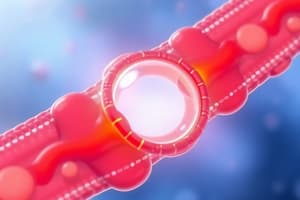Podcast
Questions and Answers
The cell membrane is impermeable to all substances.
The cell membrane is impermeable to all substances.
False (B)
What is the primary function of the cell membrane?
What is the primary function of the cell membrane?
- Produce energy
- Control the movement of substances in and out of the cell (correct)
- Store genetic information
- Synthesize proteins
The movement of molecules from an area of high concentration to an area of low concentration is called ______.
The movement of molecules from an area of high concentration to an area of low concentration is called ______.
diffusion
Match the following molecules with their ability to pass through the phospholipid bilayer:
Match the following molecules with their ability to pass through the phospholipid bilayer:
What type of transport requires energy?
What type of transport requires energy?
Which of the following is NOT a characteristic of passive transport?
Which of the following is NOT a characteristic of passive transport?
Alcohol can damage the cell membrane by dissolving the phospholipids.
Alcohol can damage the cell membrane by dissolving the phospholipids.
Why does diffusion eventually stop?
Why does diffusion eventually stop?
Diffusion refers to the movement of molecules from an area of low concentration to an area of high concentration.
Diffusion refers to the movement of molecules from an area of low concentration to an area of high concentration.
Which of the following is NOT a waste product removed from cells through diffusion?
Which of the following is NOT a waste product removed from cells through diffusion?
The movement of water molecules across a selectively permeable membrane from an area of high water concentration to an area of low water concentration is called ______.
The movement of water molecules across a selectively permeable membrane from an area of high water concentration to an area of low water concentration is called ______.
Match the following terms with their corresponding descriptions:
Match the following terms with their corresponding descriptions:
What happens to an animal cell when placed in a hypotonic solution?
What happens to an animal cell when placed in a hypotonic solution?
Which of the following processes is responsible for the movement of oxygen into cells?
Which of the following processes is responsible for the movement of oxygen into cells?
A plant cell placed in a hypertonic solution will become turgid.
A plant cell placed in a hypertonic solution will become turgid.
Explain the difference between diffusion and osmosis.
Explain the difference between diffusion and osmosis.
Flashcards
Cell Membrane
Cell Membrane
A structure that encloses all cells and controls substance movement in/out.
Phospholipid Bilayer
Phospholipid Bilayer
Two layers of phospholipids forming the foundation of the cell membrane.
Proteins in Cell Membrane
Proteins in Cell Membrane
Embedded proteins in the membrane that perform various functions like transport and signaling.
Selectively Permeable
Selectively Permeable
Signup and view all the flashcards
Diffusion
Diffusion
Signup and view all the flashcards
Passive Transport
Passive Transport
Signup and view all the flashcards
Active Transport
Active Transport
Signup and view all the flashcards
Concentration Gradient
Concentration Gradient
Signup and view all the flashcards
Importance of Diffusion
Importance of Diffusion
Signup and view all the flashcards
Osmosis
Osmosis
Signup and view all the flashcards
Hypertonic
Hypertonic
Signup and view all the flashcards
Hypotonic
Hypotonic
Signup and view all the flashcards
Isotonic
Isotonic
Signup and view all the flashcards
Plasmolysis
Plasmolysis
Signup and view all the flashcards
Turgid
Turgid
Signup and view all the flashcards
Study Notes
Cell Membrane Structure and Function
- Cells are enclosed by a cell membrane, controlling substance entry and exit.
- The membrane is composed of a phospholipid bilayer and embedded proteins.
- Phospholipid molecules allow membrane flexibility due to their movement.
- Proteins are embedded within the phospholipid bilayer, acting as enzymes, receptors, and transport channels.
- The membrane is selectively permeable, allowing some substances to pass easily, others slowly, and some not at all, determined by size and lipid solubility.
- Small, lipid-soluble molecules (oxygen, water, carbon dioxide) pass through the phospholipid bilayer.
- Larger molecules (glucose) require protein channels for transport.
- Specific proteins facilitate transport of specific substances across the membrane.
- Very large molecules cannot cross the membrane.
Diffusion
- Diffusion is the net movement of molecules from an area of high concentration to an area of low concentration.
- It occurs down the concentration gradient (no energy required - passive transport).
- The larger the concentration difference, the faster the diffusion rate.
- Diffusion stops when the concentration of the substance is equal on both sides.
- Diffusion is crucial for transporting oxygen and glucose into cells and carbon dioxide and waste products out of cells.
Active Transport
- Movement against a concentration gradient requires energy (ATP) and involves protein channels (active transport).
- Substances like larger molecules and charged ions require active transport.
Osmosis
- Osmosis is the passive transport of water across a selectively permeable membrane from a high water concentration area to a low water concentration area.
- Solutions with high solute concentrations have low water concentrations (hypertonic).
- Solutions with low solute concentrations have high water concentrations (hypotonic).
- Solutions with equal solute concentrations are isotonic.
- Animal cells placed in a hypertonic solution will shrink, and in a hypotonic solution will burst. Plant cells in a hypotonic solution become turgid, and in a hypertonic solution become plasmolysed.
Diffusion vs. Osmosis
- Diffusion is the general movement of any substance down a concentration gradient.
- Osmosis is the specific movement of water across a selectively permeable membrane, following its own concentration gradient.
Studying That Suits You
Use AI to generate personalized quizzes and flashcards to suit your learning preferences.




